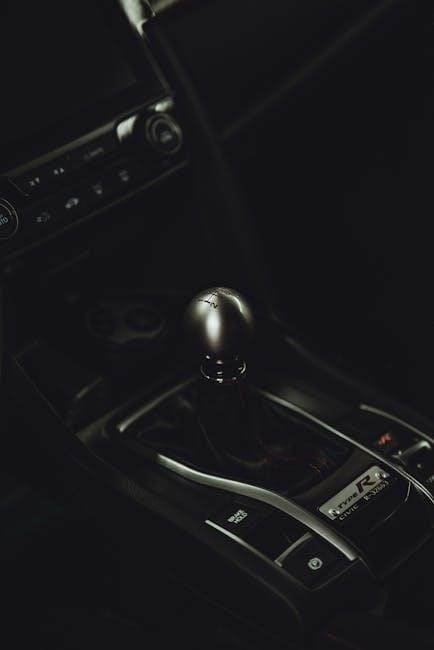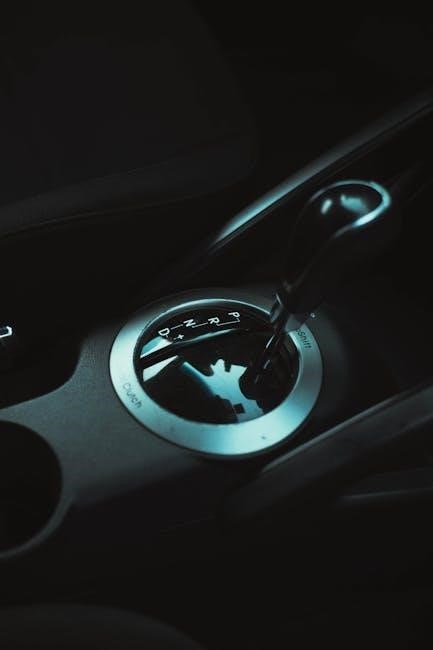Manual transmission vehicles offer unique challenges for auto-start systems due to the clutch pedal and lack of gear indicators. While remote start installation is possible, it requires careful consideration of safety features like neutral gear detection and parking brake engagement to ensure proper functionality and prevent accidents.
Overview of Manual Transmissions and Auto-Start Technology
Manual transmissions, also known as stick shifts, require driver interaction to change gears using a clutch pedal and gearshift. Unlike automatic transmissions, manuals rely on mechanical linkages to engage and disengage gears. Auto-start technology, which allows vehicles to start remotely, poses unique challenges for manual transmissions due to the need for the clutch pedal to be disengaged and the vehicle to be in neutral; Most manual vehicles lack electronic gear indicators, making it harder for remote start systems to verify the transmission’s state. However, advancements in aftermarket solutions have made it possible to integrate remote start systems with manual transmissions safely. These systems often incorporate features like neutral detection and clutch pedal integration to ensure proper operation while maintaining safety standards.

Can You Have Auto Start with a Manual Transmission?
Yes, auto-start systems can be integrated with manual transmissions, but they require additional safety mechanisms to ensure the vehicle is in neutral and the clutch is disengaged.
Understanding the Clutch Interlock Switch
The clutch interlock switch is a critical safety feature in manual transmission vehicles, preventing the engine from starting unless the clutch pedal is fully depressed. This mechanism ensures the vehicle cannot start in gear, reducing the risk of accidental movement. For remote start systems to function with a manual transmission, the interlock switch must be bypassed or integrated into the system. This typically involves wiring modifications to simulate the clutch pedal being pressed, allowing the engine to start without physical pedal input. However, improper bypassing can lead to safety hazards, emphasizing the need for professional installation and adherence to manufacturer guidelines.
How Remote Start Systems Work with Manual Transmissions
Remote start systems for manual transmissions operate by bypassing or integrating the clutch interlock switch, allowing the engine to start without physical clutch pedal input. These systems often require additional components, such as neutral gear detection sensors, to ensure the vehicle is in neutral before starting. Once activated, the remote start system simulates the clutch pedal being pressed, enabling the engine to turn over. Some advanced systems also monitor the parking brake to add an extra layer of safety. While the process is more complex than with automatic transmissions, modern remote start systems are designed to handle manual transmissions effectively, providing convenience while maintaining safety protocols. Proper installation is crucial to ensure reliable functionality.

Safety Considerations
Remote starting a manual transmission vehicle requires strict safety measures to prevent accidents. Ensuring the car is in neutral and the parking brake is engaged is essential.
Potential Risks of Remote Starting a Manual Transmission Vehicle
Starting a manual transmission vehicle remotely poses significant risks if proper safety protocols aren’t followed. The primary concern is the vehicle potentially rolling or moving unintentionally if not in neutral or with the parking brake disengaged. This can lead to accidents, especially in confined spaces like garages or crowded parking lots. Additionally, without a gear indicator, it’s challenging to confirm the vehicle’s neutral state, increasing the likelihood of unintended movement. Moreover, bypassing the clutch interlock switch can result in the engine starting without the clutch pressed, which might cause the vehicle to jerk or move unexpectedly. These risks highlight the importance of advanced safety features in remote start systems designed for manual transmissions.
Importance of Neutral Gear and Parking Brake Engagement
Engaging the neutral gear and parking brake is crucial for safely remote starting a manual transmission vehicle. Neutral gear ensures the vehicle won’t move unexpectedly, preventing accidents. The parking brake adds an extra layer of safety by securing the vehicle in place. Without these, the car could roll or jerk if the engine starts while in gear. Most remote start systems require these safety measures to function, ensuring the vehicle remains stationary during startup. This dual protection is essential to avoid potential hazards and damages, making it a cornerstone of safe auto-start installation for manual transmissions. Proper engagement provides peace of mind and prevents mishaps.

Aftermarket Solutions
Aftermarket remote start systems offer safe solutions for manual transmissions, ensuring the vehicle is in neutral and the parking brake is engaged before starting.
Recommended Remote Start Systems for Manual Transmissions
For manual transmission vehicles, Compustar stands out as a top choice, offering systems specifically designed to handle the unique challenges of stick-shift cars. These systems ensure the vehicle is in neutral and the parking brake is engaged before starting, preventing accidental movement. Additionally, Viper remote start systems are popular among enthusiasts, providing reliable performance and safety features tailored for manual transmissions. These aftermarket solutions are highly regarded for their compatibility and effectiveness, making them excellent options for drivers seeking convenience without compromising safety. Always choose systems with neutral gear detection to ensure seamless operation and peace of mind.
Installation Tips and Precautions
When installing a remote start system in a manual transmission vehicle, it’s crucial to ensure the system integrates with both the clutch pedal and parking brake. A professional installer should handle the wiring to avoid errors. The system must verify the vehicle is in neutral and the parking brake is engaged before starting. Bypassing safety features can lead to accidents. Additionally, test the system thoroughly post-installation to confirm it functions correctly. Always refer to the vehicle’s manual and the remote start system’s instructions to ensure compatibility and proper setup. This careful approach guarantees safe and reliable performance of the auto-start feature in your manual transmission car.

Functionality and Features
Advanced remote start systems for manual transmissions include neutral gear detection and clutch pedal integration, ensuring the vehicle starts safely and reliably. Proper setup is essential for seamless operation.
Neutral Gear Detection and Bypass Mechanisms
Neutral gear detection is crucial for remote starting manual transmissions, as it ensures the vehicle is in neutral before ignition. Some systems use mechanical or electronic sensors to verify the gear position. A bypass mechanism may be employed to override the clutch interlock, allowing the engine to start without depressing the clutch pedal. However, this must be done safely to prevent accidental movement. Modern aftermarket solutions often integrate both neutral detection and bypass features, providing a reliable and secure method for auto-start functionality in manual vehicles. These mechanisms are essential for maintaining safety and convenience when using a remote start system.
Clutch Pedal Integration for Safe Starting
Clutch pedal integration is a critical component for safe remote starting in manual transmission vehicles. The system typically requires the clutch pedal to be fully disengaged to activate the ignition, preventing the car from moving unexpectedly. Advanced remote start systems may include sensors or actuators that monitor the clutch pedal’s position, ensuring the vehicle is in a safe state before starting. Some setups bypass the clutch interlock switch, allowing the engine to start without physical pedal interaction. However, this must be implemented with caution to avoid potential risks. These solutions ensure that the vehicle remains stationary during remote start, providing peace of mind for drivers who choose manual transmissions.
Troubleshooting Common Issues
Remote start issues in manual transmissions often stem from the clutch interlock switch, gear position, or parking brake engagement. Ensure the clutch is disengaged, the vehicle is in neutral, and the parking brake is set. Verify proper installation and system compatibility with manual transmissions to resolve these common problems effectively.
Why Remote Start May Not Work with Manual Transmissions
Manual transmissions often lack the necessary sensors to confirm the vehicle is in neutral, making remote start systems ineffective without additional modifications. The absence of a neutral gear indicator means the system cannot verify the vehicle’s stationary status, posing a safety risk. Furthermore, manual transmissions typically require clutch pedal engagement to start the engine, which remote start systems cannot replicate without specific bypass mechanisms. These limitations can prevent remote start functionality unless specialized aftermarket solutions are installed to address these issues.
Solving Common Problems with Auto-Start Systems
Common issues with auto-start systems in manual transmissions often stem from improper installation or lack of compatibility. Ensuring the system integrates with the clutch interlock switch and neutral gear detection is crucial. Troubleshooting steps include verifying the parking brake engagement sensor and checking for any wiring issues that might prevent the system from detecting neutral gear. Additionally, selecting a remote start system specifically designed for manual transmissions can mitigate many of these problems. Proper installation by a qualified technician, along with regular system checks, can help maintain reliable functionality and ensure safety while using the auto-start feature on a manual transmission vehicle.
Auto-start systems can function with manual transmissions, but proper installation and safety precautions are essential to ensure reliable functionality and prevent potential hazards.
Final Thoughts on Auto-Start Manual Transmissions
Auto-start technology is indeed compatible with manual transmissions, offering convenience without compromising safety, provided proper precautions are taken. Modern systems integrate neutral gear detection and clutch pedal mechanisms to ensure the vehicle starts safely. Aftermarket solutions, like Compustar, are reliable options for manual transmissions, addressing potential risks such as accidental movement. Installation must prioritize safety features, including parking brake engagement and neutral verification, to prevent hazards. While the process is more complex than with automatics, the benefits of remote starting make it a viable option for manual transmission owners. Always opt for professional installation to ensure functionality and peace of mind.
